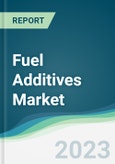The fuel additives market was valued at US$9.561 billion in 2021 and is projected to expand at a CAGR of 6.97% over the forecast period to reach US$15.322 billion by 2028.
Fuel additives help improve the efficiency of fuels like gasoline and diesel. The fuel additives market can broadly be classified into, refinery products like antioxidants, distribution system products like corrosion inhibitors, and automotive performance enhancement products like deposit control additives and cetane improvers. Factors driving growth in the market are stringent government regulations for fuel efficiency and environmental protection, increasing demand for ultra-low Sulphur diesel, and increased automobile production in large markets. Asia Pacific region is projected to witness high growth over the forecast period on account of rising automobile sales in the region.This research study examines the fuel additives market based on various segments: type, application, and geography. First, a brief overview of the market details key driving factors and challenges. Next, Porter's five forces model analyzes the Fuel additives industry comprehensively. This is followed by industry value chain analysis which determines the companies which are part of the different processes and contributing to various sectors.
The study also presents in-depth information concerning the development, trends, and industry policies and regulations affecting the Fuel additives market. Moreover, the research study analyzes the overall regulatory framework of the Fuel additives sector, offering stakeholders a better understanding of the key factors influencing the overall market environment.
Fuel additives market - Forecasts from 2023 to 2028 are a comprehensive and latest report. It provides vital market information to executives and interested stakeholders to enable them to get vital market information. The report also analyzes the competitive landscape and details strategies of key market players and also plots them on our vendor matrix in four quadrants: leader, follower, challenger, and niche.
The scope and coverage of the fuel additives market report are as below:
- Fuel additives market data tables and charts
- Market outlook with sections on drivers, restraints, Porter’s, and industry value chain analysis
- Market assessment by type into deposit control additives, cetane improvers, antioxidants, dyes, lubricity additives, corrosion inhibitors, and others.
- Detailed market trends, analysis, and graphical representation by application into gasoline, diesel, and others.
- A 360 degree view of the demand for fuel additives solutions/services across different geographies (North America, South America, Europe, Middle East and Africa, and Asia Pacific) with further breakdown for key countries within those regions.
Different segments covered under the fuel additives market report are as below:
By Type
- Deposit Control Additives
- Cetane Improvers
- Antioxidants
- Dyes
- Lubricity Additives
- Corrosion Inhibitors
- Others
By Application
- Gasoline
- Diesel
- Others
By Geography
- North America
- United States
- Canada
- Mexico
- South America
- Brazil
- Argentina
- Others
- Europe
- United Kingdom
- Germany
- France
- Spain
- Others
- Middle East and Africa
- Saudi Arabia
- UAE
- Israel
- Others
- Asia Pacific
- Japan
- China
- India
- South Korea
- Indonesia
- Thailand
- Others
Table of Contents
1. INTRODUCTION
2. RESEARCH METHODOLOGY
3. EXECUTIVE SUMMARY
4. MARKET DYNAMICS
5. FUEL ADDITIVES MARKET BY TYPE
6. FUEL ADDITIVES MARKET BY APPLICATION
7. FUEL ADDITIVES MARKET BY GEOGRAPHY
8. COMPETITIVE ENVIRONMENT AND ANALYSIS
9. COMPANY PROFILES
Companies Mentioned
- Afton Chemical Corporation
- BASF
- Lubrizol Corporation
- Huntsman Corporation
- AkzoNobel
- Lanxess (Chemtura Corporation)
- Chevron Oronite
- Evonik Industries
Methodology

LOADING...
Table Information
| Report Attribute | Details |
|---|---|
| Published | May 2023 |
| Forecast Period | 2021 - 2028 |
| Estimated Market Value ( USD | $ 9.56 billion |
| Forecasted Market Value ( USD | $ 15.32 billion |
| Compound Annual Growth Rate | 6.9% |
| Regions Covered | Global |
| No. of Companies Mentioned | 8 |









